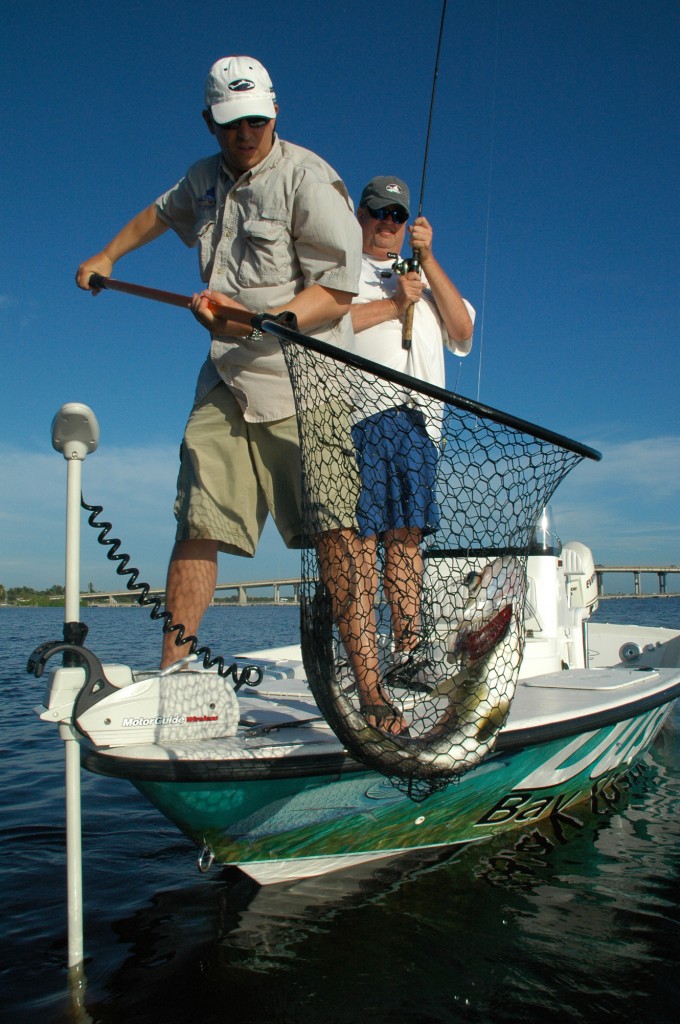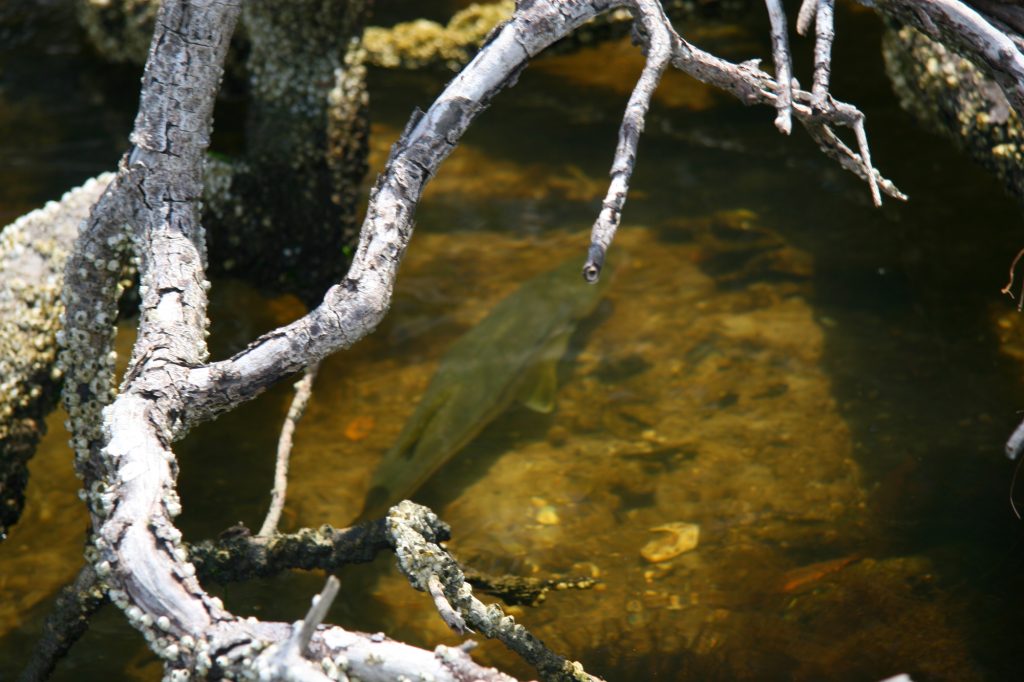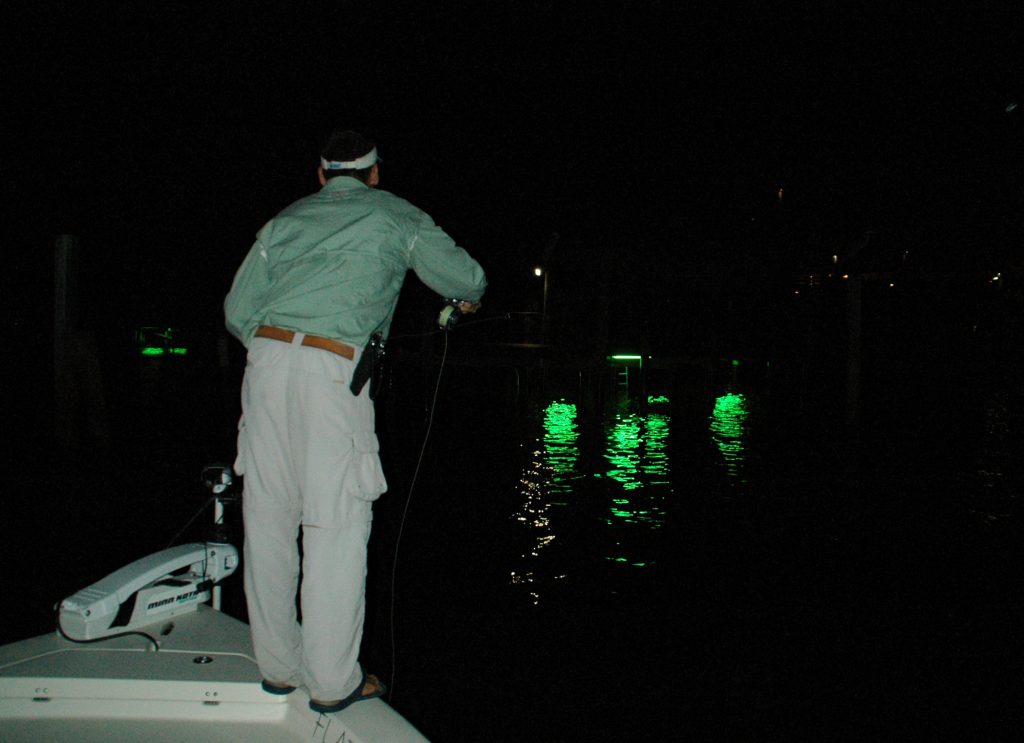November 11, 2013
By Jeff Weakley
4 patterns for tracking down late-season snook.

December is probably not the best month for snook fishing, depending on your priorities, but for many veteran anglers it's among the most compelling.
If you live on the Atlantic coast, as I do, you have those final two weeks of open season before December 15. Used to be the same for the Gulf side and Monroe County, until the state changed the season closure there to include the entire month. The winter snook closure on the Atlantic side of the state lasts until February 1; the Gulf, till March 1.
But to me there's more to winter snooking than just harvesting that 11th-hour keeper. There's mystery. You're casting for a tropical species with a cool north wind on your neck. Each day is a riddle to be solved. There are no guarantees, like there are during the summer spawning season, when you can pull up to a rocky ocean jetty, look down in the water, and count snook by the hundred. Those fish pull up stakes by September 1, and after a brief autumn feeding binge, Poof!, they disappear. Those few weeks of open season can drive you nuts.
The game gets even more complicated after a few big cold fronts rush down the peninsula. Snook don't feed much, if at all, when water temps fall below 70 degrees Fahrenheit. That's assuming you can find them in the first place.
Here are four scenarios I've learned to focus on in the waning days of autumn:
Timber: Mangroves, specifically, and not just shoreline mangroves. Winter snook show a marked affinity for downed timber. I don't know if it's the associated forage base that accrues around decaying logs, or simply a matter of blending in more efficiently (they do look like logs, don't they?), but I've noticed a clear connection. There's a tangly little creek down south of Chokoloskee that comes to mind; the creek runs from the Wilderness Waterway to the open Gulf, with deep holes and a few open pools. Some years back a hurricane went through there like a weedeater, knocking mangroves into the water all over the place. It's a headache fishing there, with a constant threat of breakoffs, but it's unbelievable how many snook rise up from that mess of old trees to whack a soft bait or topwater plug.
I've seen similar aggregations of winter snook in gnarly back bays along Pine Island Sound and the Indian River Lagoon. Whitewater Bay, in Everglades National Park, is riddled with this kind of terrain, and it's an excellent winter fishery.
Assuming a snook's basic needs are fulfilled (water above at least 65 degrees, if not higher; some moving tide; some apparent forage source), if you have to choose where to focus your fishing energy, I'd give the nod to downed timber.

Log cabin with a sunroof; perfect.
Crooked mangrove shorelines, with points jutting here and there, almost always hold submerged logs, branches and toppled trunks, especially off the points. These are prime holding areas. Don't assume the fish are back in there under the green, overhanging mangrove branches; quite often they're out a bit from shore, in some cases sunning themselves on a cool winter day. Thump an unseen log with your trolling motor or pushpole? Make a mental note to come back and fish the area.
Topwater lures are logical choices here, riding above the hook-snagging structure, but small leadheads with plastic grubtails, and weedless-rigged jerkbaits, are also great choices if you keep them moving. In borderline water temps, snook aren't as likely to go for very large baits such as mullet. Sometimes they'll rise to the swishing pattern of a full-size walking plug, but fail to commit. Small mud minnows, gobies, shrimp—that's another story. Sinking or suspending lures of no more than 4 inches take some whopping big snook in these winter holding areas.

Fly fishing is deadly on docklight snook. These fish may be keyed on very tiny forage that's hard to match with spinning or plug lures.
Lights: Night-fishing is productive in any season, but for the winter snooker it takes on a special role. Dock and bridge lights cue a feeding scenario which snook take advantage of almost regardless of temperature and tide. These may not be big fish, but they are usually aggressive. The key is to use small lures, or better yet, flies. White lipped minnow plugs, such as the Rapala X-Rap 10, often work well, retrieved briskly. Flies can be very simple—a size 4 hook with a few twists of white chenille and marabou tail, for instance, or a basic white-on-white Clouser Minnow.
Live shrimp are also productive around the lights. In Biscayne Bay and the Florida Keys, the nocturnal migration of adult pink shrimp prompts a heckuva snook bite, and those shrimp are magnetized to fixed sources of illumination. Trouble is, clear water makes it tough to fool those snook. You may have to drop down in leader size to 30-, even 20-pound-test; fluorocarbon also helps. A trick I learned a long time ago is to take a page from the kite-fishing book: Position yourself high above the feeding lane (dock, pier or other lawfully accessible structure), and drift a live shrimp with the current, making sure to keep your leader and line out of the water. This lets you get away with somewhat heavier leader, which is helpful if you manage to hook a large fish. Use a small, strong hook; in this case a J-hook. You won't get an opportunity to let the fish turn with the bait, as you'd need to do to properly set a circle hook. Wind also tips the odds of deception in your favor. It's a real kick casting to docklight snook laid-up in swimming-pool clear water, but frankly you'll have better luck if the water is a bit roiled.
Deep holes: Turning basins and dredged shipping channels harbor the monsters that led the summer spawning charge. Catching these guys is about bottom fishing; pretend they are grouper and you're headed in the right direction. A palm-size live pinfish, if you can find one, is a terrific deepwater snook bait. Nose-hook it and fish it on a 24-inch leader, 40- to 60-pound-test, behind a sliding sinker rig. Hair jigs—especially the high-profile flare hawks—heavy enough to tap bottom (do it, then reel steadily with the current) work for casting. Sources of light may attract the lunkers closer to the surface, where they may fall for a diving plug or topwater. As mentioned already, in the South Florida region (Florida Keys bridges, ports of Miami and Fort Lauderdale), deepwater snook will tune into shrimp runs. A live shrimp hooked up through the clear carapace on a leadhead jig, ½-ounce or so, is a super bait.
Sunlit Flats: It's Florida, okay? Many years winter is simply a theoretical calendar concept. Our southern latitude sun may usher summer to our doorstep nearly any month. A few days of high sun working on a muddy or grassy flat, the kind of place you might find pilchards and all sorts of other goodies in summer, may bring snook out there. Now, if the water is icy-cold, those fish may be merely attempting to warm themselves; they may even be stunned. That's not what you're looking for—though it would be worth noting in your logbook. But if the water temp is near 70 degrees, those shallow-water snook will eat. Some of the best winter flats are adjacent to freshwater creekmouths, where snook drop out of upstream thermal refuges (holes, springs) to feed during warm spells. Clear water means sight-fishing is viable, even preferable in some cases. In fact, if you aren't intimately familiar with a particular flat, it can pay to hold your fire until you identify fish, as opposed to “shotgunning” the area with intrusive casts. A poling platform or elevated casting deck is hugely valuable.
How do you sight-fish snook? Think duck hunting: Keep a low profile and blend into your surroundings. Lead your target and keep moving (the lure, in this case). And one other thing: Don't ever aim for the tail. FS
First published Florida Sportsman Dec. 2009
Click Here to Have Florida Sportsman Magazine Delivered to Your Door.
